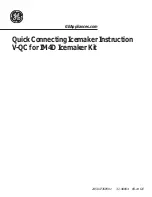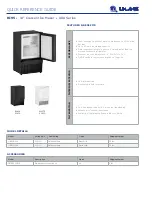
56
8.3. Heating a beverage
●
Immerse the steam wand into the liquid to be
heated.
●
Gradually turn on the steam knob 7 Fig.7; the
steam that bursts in the liquid heats it to the desired
temperature.
●
Turn off the steam knob when the desired tempe-
rature has been reached.
Immediately after carrying out this operation,
clean the wand with a sponge or clean cloth.
Be careful as the wandis hot and may burn
your hand.
8.4. Preparing tea, camomile, etc.
●
Place the jug under the hot water spout and use
the delivery control according to the model (Fig.7).
When the desired quantity has been obtained, turn
off the switch.
●
Add the beverage desired.
8.2. Preparing cappuccino
(Fig.8)
●
Pour an espresso in your cappuccino cup.
●
Use a tall and narrow jug, fill it half-way with fresh
milk.
●
Place the jug under the spout so that the nozzle
touches the bottom.
●
Turn on the steam knob and lower the jug so that
the nozzle is almost at the surface of the milk to
create froth.
●
Turn off the steam knob and pour the milk into the
cup.
Immediately after carrying out this operation,
clean the wand with a sponge or a clean
cloth so that the milk does not dry on it. Be
careful as the wand is hot and may burn
your hand.
8. USE
WATER CHANGES: at the start of each daily activity
and anyway always after machine stop periods
longer than 8 hours, it is necessary to change
100% of the water contained in the circuits via the
points appropriately provided on the machine for the
purpose.
USING THE STEAM WAND: Before using the steam
wand, it is always necessary to flush out all the resi
-
dual steam condensate for at least 2 minutes.
The machine has a top shelf on which the cups are
kept and heated, ready for use.
This is very important to obtain good coffee as the
pre-warmed cup stops the coffee from growing cold
too quickly.
8.1. Preparing coffee
●
Remove the filter-holder from the group head and
knock out any grounds into a knock box. Be careful
not to damage the rim of the filter.
●
Use the filter for 1 or 2 coffees, according to your
needs.
●
Fill the filter with the measure of coffee, level it off
and press it down gently with the tamper.
●
Remove any ground coffee that has stuck to the
rim of the filter during tamping..
If ground coffee is left on the rim of the filter, the
filter-holder will not seal properly in the group
head, and during coffee production, water or
coffee grounds may leak into the cup.
●
Lock the filter-holder into the group head firmly to
obtain a leaktight seal.
●
Place the cups under the spouts and start pouring
using control 4 or push-button panel 5 according
to your model (Fig.7).
●
When the coffee has been poured, leave filter-
holder in the group head until it’s time to produce
another coffee.
7.3. Starting up
●
Turn on the water supply tap
2 Fig.5.
●
Turn the main switch 1; The pump to fill the boiler
will activate.
●
When the water reaches the correct level, the
pump stops.
Turn the main switch 2 to begin heating the water
in the boiler then turn on each group head until
water begins to flow from them.
●
Wait for the machine to reach its working pressure
and to reach the correct thermal balance.
When pouring beware of the hot parts of the
machine especially the group heads, the
steam wand and the hot water spout. Do
not put your hands under the group heads,
water spout, or steam wand when they are
in operation.
Great tasting espresso begins with proper grinding.
High quality espresso shots should take an average
of 25-30 seconds to produce.
If the coffee is ground too coarsely, the espresso will
be pale in color and weak in flavor, with only a very
small amount of crema. If coffee is ground too fine,
it will be dark in color and have no crema.
Another important factor to consider is the freshness
of your coffee beans. Good espresso can only be
made if your beans are freshly and uniformly ground.
The grinder blades should be sharp and the dosing
mechanism of your grinder should be adjusted so that
it measures approximately 6 grams per pull.
It is important to grind your coffee fresh each time
you produce an espresso because once the beans
are ground they rapidly lose their aromatic qualities
and the oils in the beans begin to go rancid.
Summary of Contents for Classe 8 DE
Page 4: ......
Page 6: ......
Page 8: ... Fig 3 ...
Page 9: ... 4 L o v a t o L 2 3 8 G 1 Ø 30 mm Fig 4 Fig 6 Fig 5 H D C B A ...
Page 10: ...10 Fig 7 ...
Page 12: ...12 Fig 14 Fig 15 Fig 16 1 2 3 Fig 17 ...
Page 87: ...87 ...
Page 94: ......
Page 96: ...www rancilio com Cod 46900144 REV AC 09 2010 ...
















































